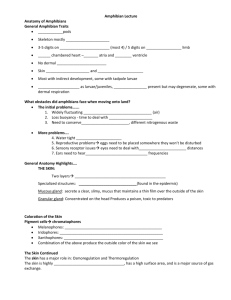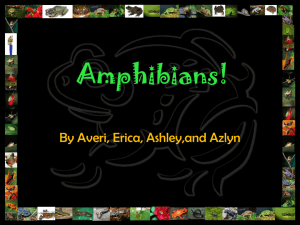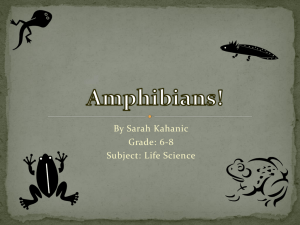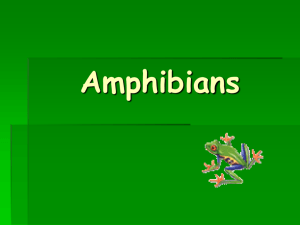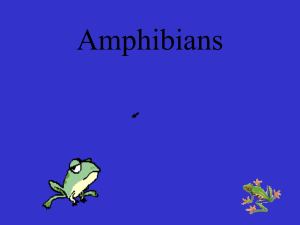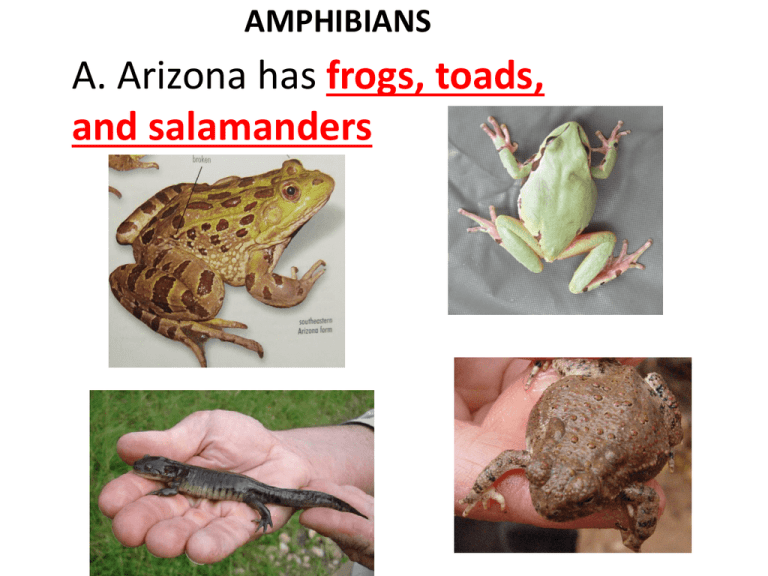
AMPHIBIANS
A. Arizona has frogs, toads,
and salamanders
GENERAL STRUCTURE: FROGS + TOADS VERSUS SALAMANDERS
Adult Frogs and Toads:
Four limbs- hind limbs larger and modified
for jumping.
No distinct neck.
No distinct tail
Adult Salamander:
Four limbs of equal size.
Distinct neck
Distinct tail
AMPHIBIAN CHARACTERISTICS
A. Life Cycle+ Amphibios or
Double life- Adult land
based, breathing with skin
and lungs. Larvae need an
aquatic environment. They
are fish-like using gills for
respiration.
GENERAL STRUCTURE
B. Amphibian skin is smooth +
moist possessing numerous mucous
glands. They are capable of
breathing through their skin or
cutaneous breathing. This is
especially important while they are
dormant.
North American toads have toxic
skin glands as do many central +
South American tree frogs.
AMPHIBIAN CHARACTERISTICS
C. Amphibians have 4 limbs.
D. Reproduction involves an external fertilization and an
egg laying or oviparous pattern. Eggs have a jelly-like
covering and will dry out if not in a moist environment.
E. Thermoregulation: Amphibians are heterotherms and
ectotherms.
NUTRITION AND REPRODUCTION
III Nutrition: The larval stage (tadpoles in frogs + toads
and waterdogs in salamanders) are omnivores, while
the adults are carnivores.
IV. Reproduction:
A. The breeding season for frogs + salamanders is
spring, while toads breed during monsoon rains of
July and August.
B. Behavior:
1. Amphibians call/croak for, sex recognition,
species recognition and to establish a territory.
AMPHIBIAN REPRODUCTION
2. Amplexus is the mating embrace of amphibians.
3. Time of development from egg to adult:
a. Sonoran Desert toad = 30 days
b. Woodhouse toad = 34-45 days
c. Red Spotted Toad = 40-60 days
d. Bullfrog =
2 years
Spadefoot Toad = 9-21 days. This is some of the fastest vertebrate
development known. To speed up development and win the survival
race, spadefoot tadpoles do the following:
1. Secrete growth inhibitors to slow down the growth of
competitors.
2. Become cannibals, eating smaller + weak tadpoles.
3. Have the ability to withstand higher temperatures than the
adults.
4. Swarm to absorb more heat.
5. Have an omnivorous mode of nutrition.
ANPHIBIAM DIVERSITY IN ARIZONA
According to this reference, Arizona
has 1 native species of salamander
and 24 species of frogs and toads,
including the Arizona Tree Frog, the
Arizona state amphibian.
AMPHIBIANS IN TROUBLE
A. Batrachochytrium dendrobatidis (Bd for short) is a type of
pathogen chytrid fungus that has attacked at least 200 species of
amphibians globally.
1. The fungus attacks keratin a protein found in the mouthparts of
tadpoles and the skin of the adult.
2. Several theories exist as to what kills the frogs, including
introduction of toxins, or enzymes, disruption of skin + opportunistic
infections.
AMPHIBIANS IN TROUBLE
3. It appears that the original source of this disease may
have been the African clawed frog, which (1930s) was
shipped around the world for use in human pregnancy
tests.
4. There is evidence that the American bullfrog also
may be responsible for some of the spread of the
disease.
5. In the Sonoran desert region, Bd has been found in a
variety of frog species, tree frogs and even the tiger
salamander.
6. Bd is considered the worst ever recorded disease
among global wildlife. Left unchecked, it may
contribute to the extinction of 100’s if not 1000’s of
species of amphibians.



